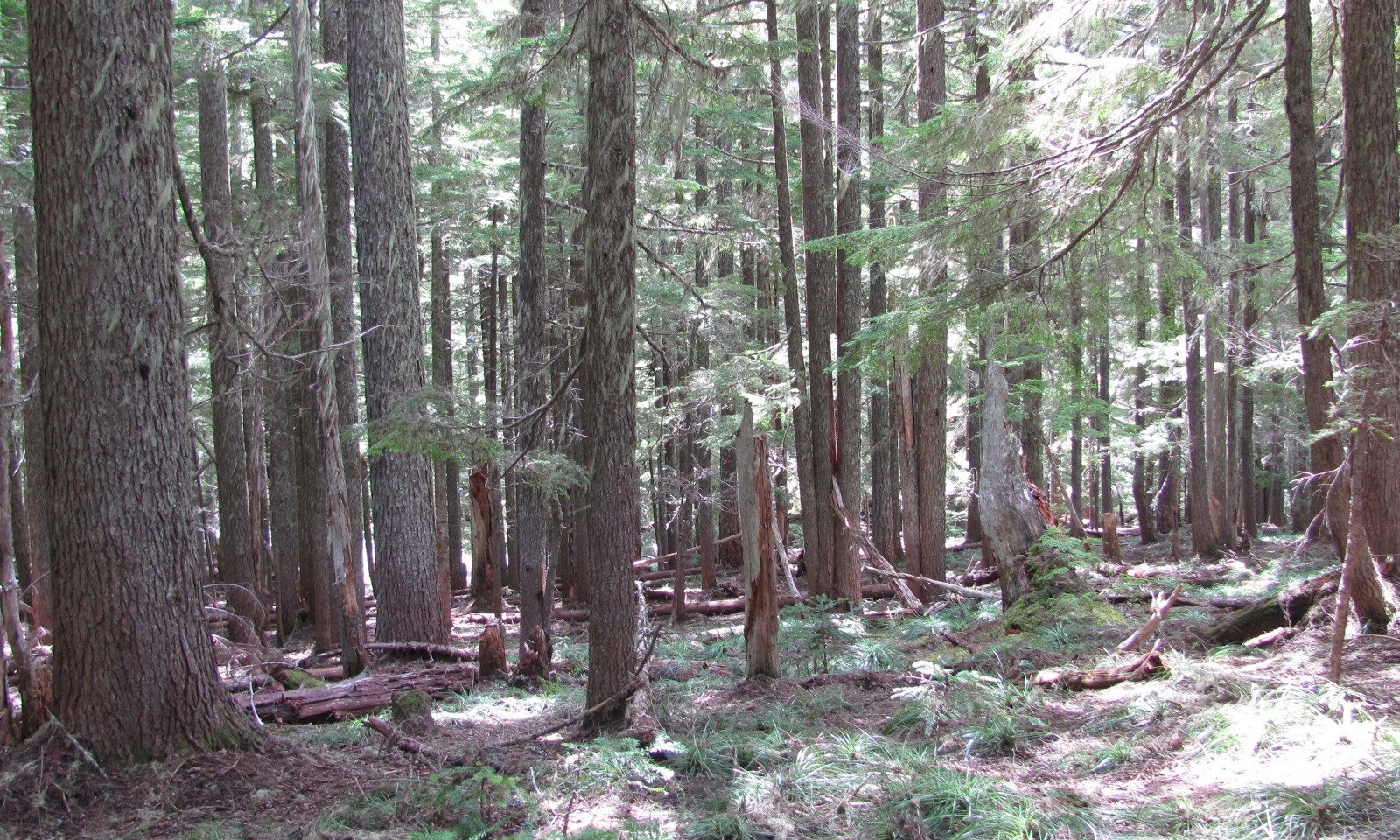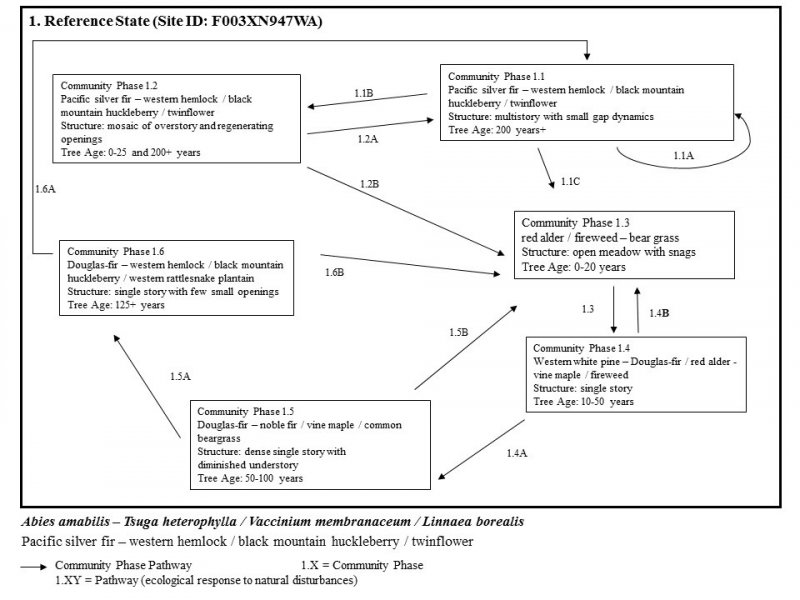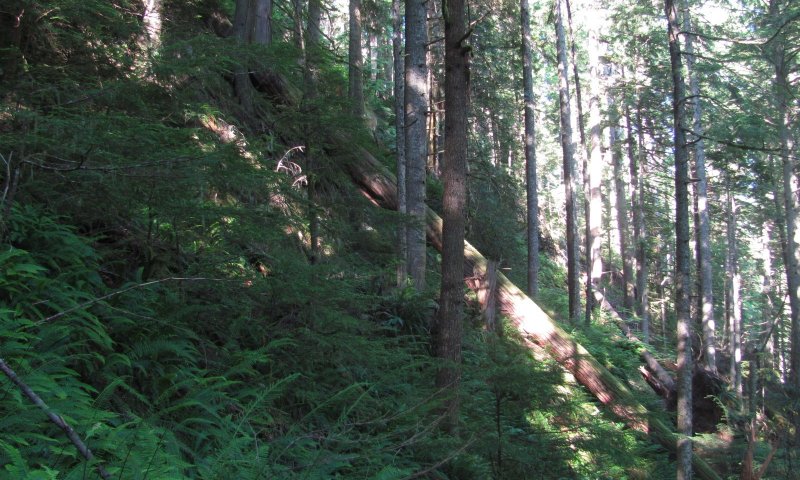Ecological dynamics
This ecological site is in cold, moist areas at the middle elevations (2,600 to 4,900 feet) on the west side of the Cascade Crest. The site commonly is on debris aprons, bedrock benches, ridges, and glacial-valley walls. The mild, temperate climate supports a variety of flora and fauna.
The most common overstory species are Pacific silver fir (Abies amabilis) and western hemlock (Tsuga heterophylla). Other common species include noble fir (Abies procera), western redcedar (Thuja plicata), Douglas-fir (Pseudotsuga menziesii), western white pine (Pinus monticola), and Engelmann spruce (Picea engelmannii).
Common understory shrubs include black mountain huckleberry (Vaccinium membranaceum), red huckleberry (Vaccinium parvifolium), prince’s pine (Chimaphila umbellata), bunchberry dogwood (Cornus canadensis), and vine maple (Acer circinatum). Common forbs include twinflower (Linnaea borealis), western swordfern (Polystichum munitum), deerfoot vanillaleaf (Achlys triphylla), myrtle pachistima (Paxistima myrsinites), and common beargrass (Xerophyllum tenax). As the stand ages, competition for moisture and sunlight increases mortality of the vegetation. This results in a wide range of snag maturation and an abundance of coarse woody debris on the forest floor.
The most common disturbance on this site is windthrow. Pacific silver fir and western hemlock are susceptible to windthrow. The resulting openings in the canopy allow more sunlight to reach the forest floor. Other disturbances include forest pathogens, such as root rot, and high-intensity, low-frequency (300 years or more) fires that are stand replacing.
Community 1.1
Pacific silver fir-western hemlock/black mountain huckleberry/twinflower
Structure: Multistory with small gap dynamics
Pacific silver fir and western hemlock are the most common overstory species in the reference community. This forest group and reference community are considered most characteristic of Mount Rainier National Park (Crawford, 2009). Pacific silver fir and western hemlock are perhaps the most shade-tolerant tree species in North America (Crawford, 1990). Douglas-fir, noble fir, and western redcedar are present; however, minimal, if any, regeneration of Douglas-fir occurs in closed-canopy forests. The dense canopy created by multiple age groups of hemlocks may block most of the sunlight from the forest floor, leading to sparse understory in some areas. Gaps in the mid-canopy and overstory allow sunlight to reach the ground. Most of the understory plants are in these areas. The understory is more continuous in areas where there is no mid-canopy. The most common natural disturbance is the small gap dynamics resulting from the mortality of trees or from windthrow. Common understory species include twinflower, black mountain huckleberry, rattlesnake plantain, Cascade Oregon grape, red huckleberry, common beargrass, and deerfoot vanillaleaf.
Community phase pathway 1.1A
This pathway represents a minor disturbance, such as small pockets of root disease, individual tree mortality, and windthrow, that maintain the overall structure of the reference community. Mortality of individual trees or clusters of trees creates gaps in the understory that allow sunlight to reach the forest floor. This promotes growth of forbs and shrubs and regeneration of overstory species, and it perpetuates a multi-storied, uneven-aged forest.
Forest overstory. The forest has multiple canopy layers. The upper canopy is 90 to 195 feet in height, and it averages 115 feet. The diameter of the trees varies depending on the species. The average diameter at breast height is 22 inches. The diameter of Douglas-fir and western hemlock trees is the largest; it is more than 30 inches in some areas.
Dominant plant species
-
Pacific silver fir (Abies amabilis), tree
-
western hemlock (Tsuga heterophylla), tree
-
noble fir (Abies procera), tree
-
Douglas-fir (Pseudotsuga menziesii), tree
-
western redcedar (Thuja plicata), tree
-
thinleaf huckleberry (Vaccinium membranaceum), shrub
-
Cascade barberry (Mahonia nervosa), shrub
-
red huckleberry (Vaccinium parvifolium), shrub
-
vine maple (Acer circinatum), shrub
-
pipsissewa (Chimaphila umbellata), shrub
-
twinflower (Linnaea borealis), other herbaceous
-
common beargrass (Xerophyllum tenax), other herbaceous
-
western swordfern (Polystichum munitum), other herbaceous
-
sweet after death (Achlys triphylla), other herbaceous
-
Oregon boxleaf (Paxistima myrsinites), other herbaceous
-
bunchberry dogwood (Cornus canadensis), other herbaceous
Community 1.2
Pacific silver fir-western hemlock/black mountain huckleberry/twinflower
Structure: Mosaic of mature overstory and regenerating openings
Community phase 1.2 has some areas that resemble community phase 1.1, but it also has moderate-sized openings (2 to 4 acres). Pacific silver fir is susceptible to windthrow, which results in small openings in the forest that allow less shade-resistant trees to establish (Crawford, 1990). Many of the shrubs in the ecological site, including red huckleberry, black mountain huckleberry, Cascade Oregon grape, and vine maple, respond well to increased sunlight. This may delay or prevent reforestation of the openings.
Community 1.3
Red alder/fireweed-common beargrass
Structure: Open meadow with snags
Community phase 1.3 is an early seral plant community that has been impacted by a stand-replacing disturbance such as a wildfire, large-scale windstorm, mass movement, or major insect infestation. Most of the trees are destroyed, but some trees may survive in the overstory. Standing, decaying snags are prevalent. The understory is dominantly shrubs and forbs such as red alder, fireweed, common beargrass, and arctic lupine. Some grasses will become established, but they will be replaced by shrubs over time. Tree seedlings and saplings will begin to establish within 3 to 10 years, depending on the severity of the disturbance.
Community 1.4
Western white pine–Douglas-fir/red alder–vine maple/fireweed
Structure: Single story
Community phase 1.4 is an early seral forest under regeneration. Scattered remnant mature trees may be present. The species composition depends on the natural seed sources present and the intensity of the disturbance. Following a moderate or severe fire, shrubs are likely to outcompete tree seedlings. Vine maple, red alder, red huckleberry, black mountain huckleberry, and Cascade Oregon grape, which may have been moderate in abundance previously, have the capacity to recover rapidly and spread when top-killed. This slows the successful regeneration of the overstory. Seed sources for tree species are from the surrounding areas of undisturbed forest and from surviving trees. The mixed stand can include Douglas-fir, western hemlock, and noble fir.
Community 1.5
Douglas-fir–noble fir/vine maple/common beargrass
Structure: Dense single story with diminished understory
Community phase 1.5 is in the competitive exclusion stage. Scattered remnant mature trees may be present. Individual trees compete for the available water and nutrients. Douglas-fir and noble fir are dominant in the overstory; however, more shade-tolerant species such as saplings of Pacific silver fir and western hemlock increase in basal area as saplings. Vine maple commonly is prolific in the understory, but it decreases in abundance as the canopy becomes more dense. The canopy is nearly 100 percent closed; thus, the shrub and forb layers are diminished. Some understory species better adapted to at least partial shade, such as twinflower and black mountain huckleberry, will increase in abundance. Over time, the forest will begin to self-thin as a result of the competition. The species composition depends on the available seed sources. The forest may consist of a single species or mixed species, including Douglas-fir, western hemlock, noble fir, Alaska cedar, or Pacific silver fir.
Community 1.6
Douglas-fir–western hemlock/black mountain huckleberry/western rattlesnake plantain
Structure: Single story with few small openings
Community phase 1.6 is a maturing forest that is becoming differentiated vertically. Individual trees are dying from competition, disease, insects, or windthrow, which allows some sunlight to reach the forest floor. The understory increases, and the overstory tree species regenerate in some areas. The abundance of less shade-tolerant species such as Douglas-fir and noble fir decreases, and the abundance of more shade-tolerant species such as western hemlock and Pacific silver fir increases.
Pathway 1.1B
Community 1.1 to 1.2
This pathway represents a larger disturbance, such as a windstorm, insect infestation, or pocket of root rot. Areas of regeneration are 2 to 4 acres in size. Historically, this spatial pattern was caused by pockets of disease, such as annosum root rot (Heterobasidion annosum) or laminated root rot (Phellinus weirii), minor insect infestations, or fires of low to moderate intensity. Pacific silver fir is susceptible to windthrow. The resulting small openings in the forest allow less shade-resistant trees to establish (Crawford, 1990).
Pathway 1.1C
Community 1.1 to 1.3
This pathway represents a major stand-replacing disturbance, such as a high-intensity fire, large-scale windstorm, major insect infestation, or large mass movement. The frequency of fire is 300 to 500 years. Volcanic activity may disrupt the ecology of the landscape beyond the boundaries of the ecological site and the purpose of this site description.
Pathway 1.2A
Community 1.2 to 1.1
This pathway represents growth over time with no further significant disturbance. The areas of regeneration go through the typical phases of stands, including competitive exclusion, maturation, and understory re-initiation, until they resemble the old-growth structure of the reference community.
Pathway 1.2B
Community 1.2 to 1.3
This pathway represents a major stand-replacing disturbance, such as a high-intensity fire (typical interval of 300 to 500 years), large-scale windstorm, major insect infestation, or large mass movement. This leads to the initiation phase of forest development.
Pathway 1.3
Community 1.3 to 1.4
This pathway represents growth over time with no further major disturbance.
Pathway 1.4B
Community 1.4 to 1.3
This pathway represents a major stand-replacing disturbance, such as a high-intensity fire, large-scale windstorm, major insect infestation, or large mass movement. This leads to the initiation phase of forest development.
Pathway 1.4A
Community 1.4 to 1.5
This pathway represents growth over time with no further major disturbance.
Pathway 1.5B
Community 1.5 to 1.3
This pathway represents a major stand-replacing disturbance, such as a high-intensity fire, large-scale windstorm, major insect infestation, or large mass movement. This leads to the initiation phase of forest development.
Pathway 1.5A
Community 1.5 to 1.6
This pathway represents growth over time with no further major disturbance.
Pathway 1.6A
Community 1.6 to 1.1
Douglas-fir–western hemlock/black mountain huckleberry/western rattlesnake plantain
Pacific silver fir-western hemlock/black mountain huckleberry/twinflower
This pathway represents growth over time with no further major disturbance. Continued growth over time and ongoing mortality result in further vertical diversification. The community begins to resemble the structure of the reference community, including small pockets of regeneration and a more diversified understory.
Pathway 1.6B
Community 1.6 to 1.3
This pathway represents a major stand-replacing disturbance, such as a high-intensity fire, large-scale windstorm, major insect infestation, or large mass movement. This leads to the initiation phase of forest development.




